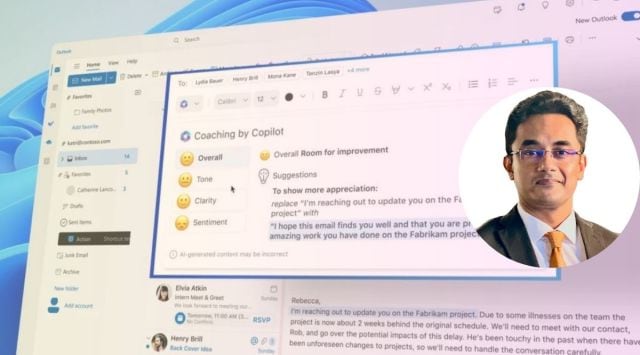Artificial Intelligence is the buzzword of the year. Even as companies around the world are adopting various AI-backed technologies, tech giant Microsoft has integrated it into a variety of tools that are essential for organisational growth. These tools are mostly aimed at boosting productivity and helping millions of professionals to organise their work in the most efficient manner.

The indianexpress.com got in touch with Bhaskar Basu, Country Head – Modern Work, Microsoft India recently. In view of Microsoft’s latest announcements, Basu spoke at length about how AI is transforming the workspace and some insights on the Viva Copilot.
Below is a glimpse of the questions and answer session with Basu:
What are your thoughts on the AI momentum and what do you mean by AI as a Copilot?
There is a tremendous amount of curiosity, excitement and a sense of expectation to demystify trends and technologies related to generative AI. We are hearing about Dall-E, ChatGPT, Viva, Microsoft Copilot, etc. I am extremely excited about where we find ourselves today and I truly believe that we are in an entirely new era of computing. There is a lot that is being said about the emergence of something we know as ‘powerful new foundation models’ and accessible natural language interfaces. This is indeed an exciting new phase of AI.
With the current generation of AI, it is evident that we are shifting from autopilot to copilot mode. Here, I use the term “copilot” as an analogy to an aeroplane. In this analogy, the pilot charts the course, navigates, provides directions, and handles takeoff and landing. The pilot’s clear mission is to safely transport passengers from point A to point B. The idea of a copilot in AI is to act as a companion that alleviates the burden of repetitive tasks and becomes an ally to the pilot. The copilot’s role is to support the pilot in achieving their vision, strategy, and overall purpose. Hence, the term “copilot” represents this concept of an AI ally.
How has AI been shaping at Microsoft?
Microsoft has been an AI company for a long time, and recently we have made significant strategic investments to enhance our copilot capabilities. Along with Viva, we have introduced various offerings such as Azure Open AI Services, GitHub Copilot, Dynamics 365 Copilot, security copilot, and Microsoft 365 Copilot. These initiatives bring together a range of technologies, including cognitive services, machine learning, digital twins, and deep learning. Our goal is to incorporate generative AI capabilities into multiple consumer and commercial products, simplifying lives and unlocking creativity, productivity, and overall capability. We are thrilled about the possibilities and eager to push the boundaries of what AI can achieve. It’s an exciting time for us.
Story continues below this ad
How do you think Microsoft 365 will help in eliminating repetitive and mundane tasks, allowing staff to dedicate more time to meaningful work?
We are a highly productive organisation and Microsoft 365 applications such as Word, Excel, Outlook, PowerPoint, Teams, etc., are key to unlocking productivity. In the last decade, we have integrated AI powers such as predictive responses in Teams and voice prompts in Outlook. The inflection point for core productivity came with the introduction of the M365 copilot, which aims to reimagine the productivity experience by leveraging human words. The copilot combines the Microsoft 365 apps, the Microsoft Graph (which stores contextual signals), and a Large Language Model (LLM) capable of processing natural language.
The copilot system understands your requests, applies privacy and security principles, and generates simplified responses to enhance task completion. This copilot approach simplifies productivity by condensing content, converting documents, and generating images through text input. It’s a confluence of apps, the Microsoft Graph, and the LLM, providing easy-to-action text. This is the Microsoft 365 copilot.
How do Viva and its features enable effective employee engagement?
Over the past few years, the Covid-19 pandemic has changed the way we work and highlighted the importance of employee experience. Organisations have realised the significance of focussing on connection, insight, purpose, and growth to enhance employee engagement. In response to these insights, Microsoft developed Viva, a comprehensive platform that addresses these objectives. Viva leverages AI and machine learning capabilities to deliver some valuable features.
Insights, for example, allows managers to gain qualitative input from their team members, analyse trends, and make informed decisions. Viva Topics simplifies content discovery by scanning the network, aggregating relevant information, and connecting people working on similar topics. Viva Learning offers personalised learning pathways, that align with employees’ career goals and development needs. Glint, which will be integrated into Viva, helps organisations listen to employee feedback and take action to improve the employee experience. Lastly, Viva Goals provides clarity and alignment by defining individual and team goals and driving purposeful actions.
Story continues below this ad
These capabilities within Viva are designed to enhance productivity, efficiency, communication, and employee experience. They leverage technology to simplify tasks, provide insights, and offer personalised experiences. Microsoft recognises the importance of continuously evolving these features to meet the evolving needs and expectations of employees.
How does Viva Glint simplify the process of feedback and how does it simplify the overall employee experience journey for both leaders and staff?
Glint aims to consistently assess and improve employee engagement by seeking and acting on feedback. Copilot and Viva Glint assist leaders in summarising and analysing large volumes of employee comments, saving significant time. By engaging with the copilot through simple written language, leaders can request pain point summaries or actionable intervention recommendations. Connecting this capability with objectives and key responsibilities (OKRs) allows leaders to develop business and people strategies based on feedback outcomes. Glint simplifies the leader’s journey by correlating data, providing summaries, and offering actionable insights. Microsoft plans to incorporate copilot capabilities across other modules in Viva, aiming to streamline the overall employee experience for both leaders and employees.
How is Microsoft safeguarding employee data and privacy with all these AI interventions in its applications?
Responsible and ethical AI is a priority for Microsoft which also lays a strong emphasis on privacy, compliance and security. Copilot adheres to organisation-level security, compliance, and privacy policies within Microsoft 365. It ensures that AI assimilates and renders content only to users who have proper access, respecting existing rights controls. Individual users can access data based on their permissions, and personal data is not used to train or improve language models. Insights and reports provided to leaders are aggregated and de-identified to protect privacy. Microsoft employs various principles and technologies to enforce these fundamentals.
How do you think AI will impact the role of leaders going forward?
Our research indicates that leaders are increasingly adopting AI and anticipating greater capabilities. This aligns with the idea of using AI as an ally, a companion, and a co-pilot. Personally, I am extremely excited about this capability. Early preview demos have shown me the potential to unlock productivity and simplify everyday tasks using natural language. As a leader, I can offload the learning curve, focus on strategic thinking, and make myself more productive. Enterprise AI is disrupting workplaces, offering real-time insights, well-being monitoring, and the ability to set team objectives. This technology presents a compelling opportunity for organisations and individuals to embrace and shape it as an ally in achieving their objectives.









